Wednesday 28 February 2018
Tuesday 27 February 2018
Meet Vero, the barely-functional app gunning for Instagram’s audience

In the last few days a fledgling social media app shot to the top of the free app charts. Vero is a bit of Facebook, Twitter, and Instagram all rolled into one and it’d undoubtedly be over the moon dethroning any or all of those apps. Spoiler alert: it won’t. Vero has been on the market for three years. Recently, certain contingents of vloggers and ‘Grammers (is that what Instagram stars are called? If not, it should be) have started advertising their moves to Vero. This has caused such a dramatic upswing in user numbers that the app crashes repeatedly —…
This story continues at The Next Web
Or just read more coverage about: Instagram
from Social Media – The Next Web http://ift.tt/2FAZtiz
via IFTTT
Monday 26 February 2018
Thursday 22 February 2018
Kylie Jenner’s tweet hurt Snapchat. Its users are destroying it.
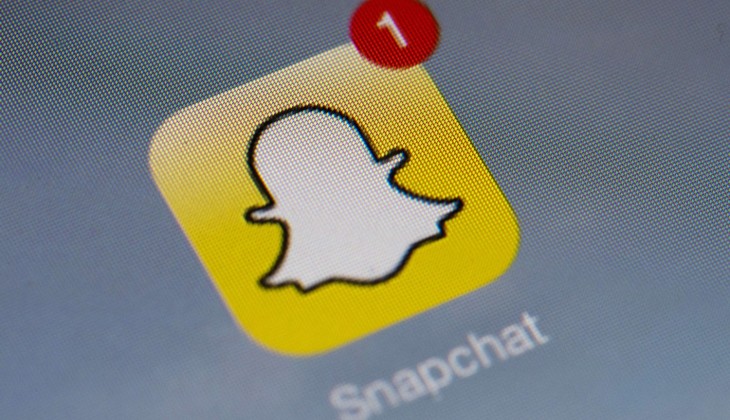
Kylie Jenner yesterday tweeted that she wasn’t using Snapchat anymore, and today the company’s stock took a major hit. But it wasn’t just Kylie who’s falling out of love with the app — users are already on their way out due to a very unpopular new update. The tweet, by itself, doesn’t sound too damning: sooo does anyone else not open Snapchat anymore? Or is it just me… ugh this is so sad. — Kylie Jenner (@KylieJenner) February 21, 2018 Considering Kylie recently gave birth to her daughter Stormi, I initially took this to mean that she wasn’t able to…
This story continues at The Next Web
Or just read more coverage about: Snapchat
from Social Media – The Next Web http://ift.tt/2ENC3VJ
via IFTTT
Wednesday 21 February 2018
Exciting News! 5 NEW Features Have Hit Your AWeber Account

Your confirmation emails have a new design
We recently rolled out a modern, super-clean HTML design for your confirmation email a.k.a. the first email your new subscribers will see when they join your list. What you need to know:
What you need to know:
- Your message will look great on desktops and mobile devices since it's an HTML design. 📱
- We replaced that long opt-in link with a simple blue button that says "Confirm my subscription." 👈
- We tested this new design and have seen opt-in rates — the number of subscribers saying "YES! I want to join your list!" — jump up significantly. 🚀
- You don’t have to do anything! All confirmation emails sent from AWeber now use this new design.
- If you have any visual references to the old design, such as on your thank you pages, or within any videos, we recommend that you update to display the new email. Contact us by phone, chat, or email if you have any questions.
The drag-and-drop editor is better than ever
Creating a beautiful and engaging email should be simple and enjoyable. After all, your crafting a message that hundreds or thousands of people might read. We listened closely to customer feedback about our drag-and-drop message editor and made some tweaks to significantly improve your creation process. What you need to know:- We improved one of the key features of any drag-and-drop editor . . . the dragging and dropping! Look for a new indicator to show you exactly where the selected element will drop as you move its location. Indicator code name: the dog bone! 🍖
- When moving elements around, your entire layout used to shift immediately, which was jarring. In fact, it was easy to forget where your element started before you moved it! We fixed this by maintaining your email's layout until you actually drop the element where you want it.
- There’s also a faded placeholder where the element began. That way, if you change your mind and decide to put it back, you’ll know right where to drop it. Code name: ghosting. 👻
 How to take advantage of this feature:
How to take advantage of this feature:
- Drop into the drag-and-drop editor today, select one our new templates or one of your own, and have some fun crafting a new message.
It's now easier to personalize your email content
Using personalized contextual content in your emails is key to sending engaging campaigns. You can insert your subscribers' first names, or the URL where they signed up. You can also insert things like the current date, your signature, or an unsubscribe URL. There’s plenty to explore. So we completely revamped the dropdown menu. What you need to know:- Easily select variables based on their category using this menu. You can also create your own custom snippets in list settings, which will appear in this menu.
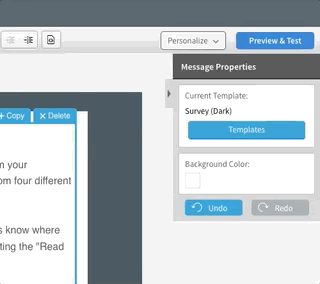 How to take advantage of this feature:
How to take advantage of this feature:
- Include relevant and personal subscriber snippets when appropriate to build a stronger connection with your audience.
- New to personalization? Here’s a quick Knowledge Base article to help you get started.
Survey your audience with a new interactive email template
This new template release can truly change the way the your interact with your audience. We wanted to know what our subscribers thought of our emails, so we developed our own handy sentiment widget. This inspired us to do even more surveying within emails, and we’ve constructed a template so YOU can do the same.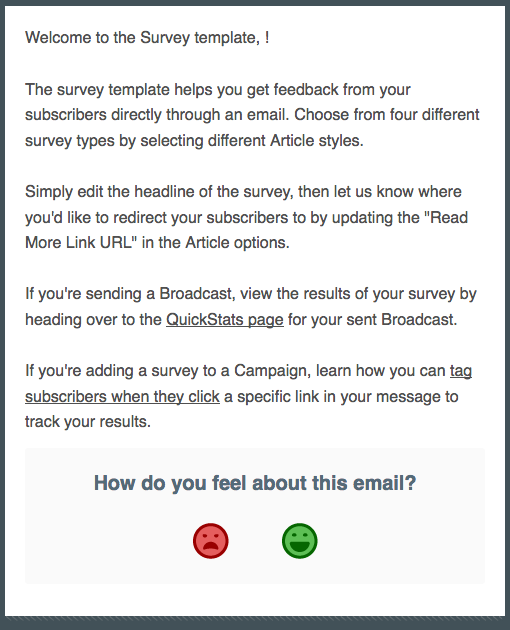 What you need to know:
What you need to know:
- Using the brand-new survey template, you can utilize 4 different survey types directly within your emails. ☑
- Gauge the sentiment of your audience by asking them to click simple happy/sad faces, yes or no questions, a five-point scale, or by using the Net Promoter Score method.
- View your results through QuickStats and create smart segments based on your subscribers’ responses.
- This robust Knowledge Base article will help you get started with our new survey template.
- Watch the GIF below to see your survey options in action.
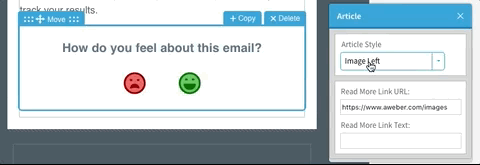
Create, edit, and send messages from your mobile device
Our mobile app Curate is the perfect way to create and send a message from your mobile device, whether you're on-the-go or you just prefer to work on your phone or tablet. With Curate, you can collect and share content from around the web, or draft your own content using a simple editor. We’ve spent the past month making some design and usability improvements, including the ability to schedule your messages in advance.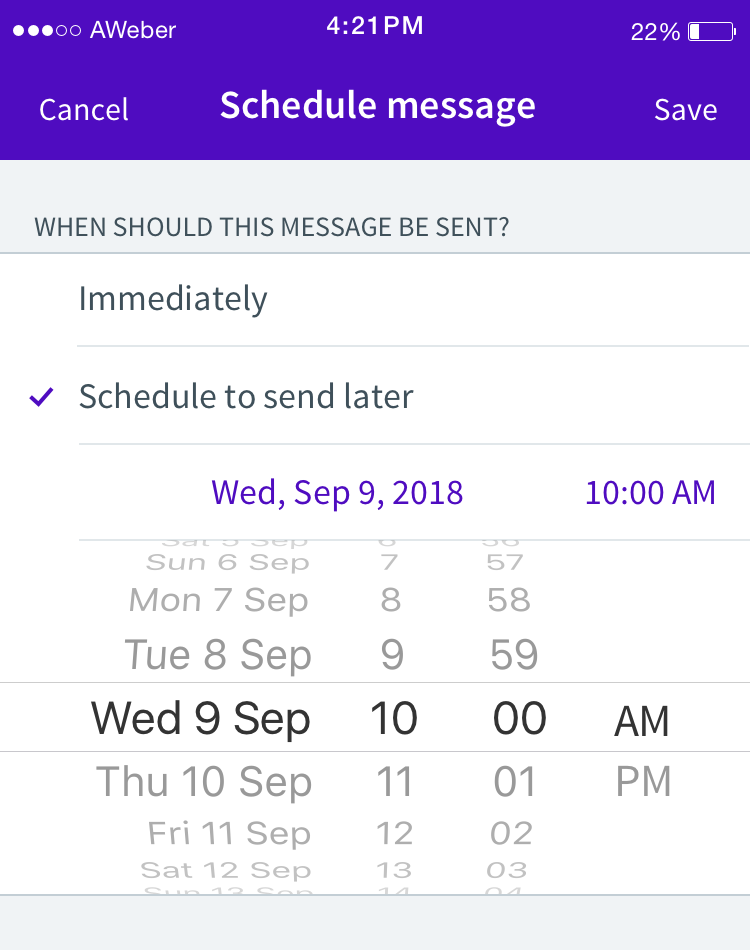 What you need to know:
What you need to know:
- Using AWeber’s Curate app for Android and iOS, you can now create an email on your mobile device and schedule it to be sent at a later time. 📅
- When you schedule a message to be sent, you can even review it on your desktop by signing into AWeber.com. You can modify or cancel the message, as needed. 📝
- If you haven’t checked out Curate, download it today for your Android or iOS device.
- Check out our Knowledge Base article to learn more about curating content and scheduling your emails.
- Or, watch this super fun video that our Director of Product Chris put together and learn how to create and schedule a message entirely on your iPad.
Getting started with AWeber
We're just getting started. Our roadmap for 2018 is filled with innovative new functionality to help your business take off. We can’t wait to roll out more updates in the coming months. Ready to start growing and engaging your audience? Log in today to start using these features. Have questions? Give us a call, or start a live chat! Not using AWeber? Join the fun! Start building your email list with AWeber today.The post Exciting News! 5 NEW Features Have Hit Your AWeber Account appeared first on Email Marketing Tips.
from Email Marketing Tips http://ift.tt/2Cb79Jf
via IFTTT
Tuesday 20 February 2018
Research finds Facebook holds personally identifiable data on 40% of EU population

The EU’s massive General Data Protection Regulation (GDPR) will go into effect on May 25, which introduces harsher restrictions on how businesses can use and store the personal data of their customers. This will greatly affect foreign tech companies that operate within the EU, since they cannot use personal data as freely and as lucratively as they used to. Facebook is one of those companies and it will have to completely change its approach to personal data — at least for their European users — according to a recently published study by researchers at the University Carlos III of Madrid.…
This story continues at The Next Web
Or just read more coverage about: Facebook
from Social Media – The Next Web http://ift.tt/2CzXGXF
via IFTTT
Monday 19 February 2018
Friday 16 February 2018
Thursday 15 February 2018
Wednesday 14 February 2018
Google becomes the latest tech giant to join the ‘let’s rip off Snapchat’ club
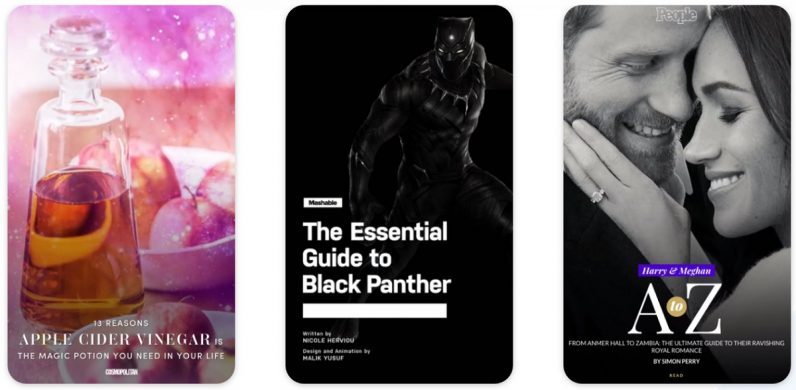
Google this week announced a feature called AMP Stories, a shortform visual medium through which Google could deliver curated news. Within minutes of this announcement, everyone was calling it a copy of Snapchat. I checked out the feature and, yeah, it’s pretty much Snapchat. Specifically, it’s very similar to Snapchat Discover, which breaks down stories and content into bite-sized visual chunks. It’s also a lot like Twitter’s Moments, which are themselves very similar to Snapchat Discover. To recap, that means Google joins the likes of Facebook, Instagram, Twitter, LinkedIn, WhatsApp and even Patreon in copying Snapchat. Even Snapchat seems resigned…
This story continues at The Next Web
Or just read more coverage about: Google,Snapchat
from Social Media – The Next Web http://ift.tt/2EF1CM2
via IFTTT
NBC releases 200k deleted tweets from the Russian propaganda machine
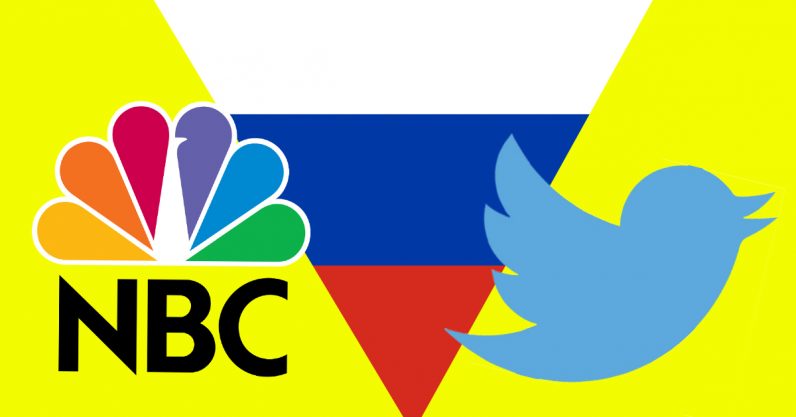
NBC News today made available a database of more than 200,000 tweets from the (allegedly) state-sponsored Russian troll farm known as the Internet Research Association (IRA). The accounts responsible for the tweets come from the list Twitter submitted to congress last year as part of the ongoing US investigation into Russian election interference. They’ve been identified as belonging to the Russian IRA and the tweets sent from those accounts are paid propaganda created with the intent of influencing American elections — all of the tweets in the database come from 2016. Twitter, for its part, deleted the tweets and suspended…
This story continues at The Next Web
from Social Media – The Next Web http://ift.tt/2szKxhO
via IFTTT
I Sent Only 100-Word Emails for One Year and Here’s What Happened

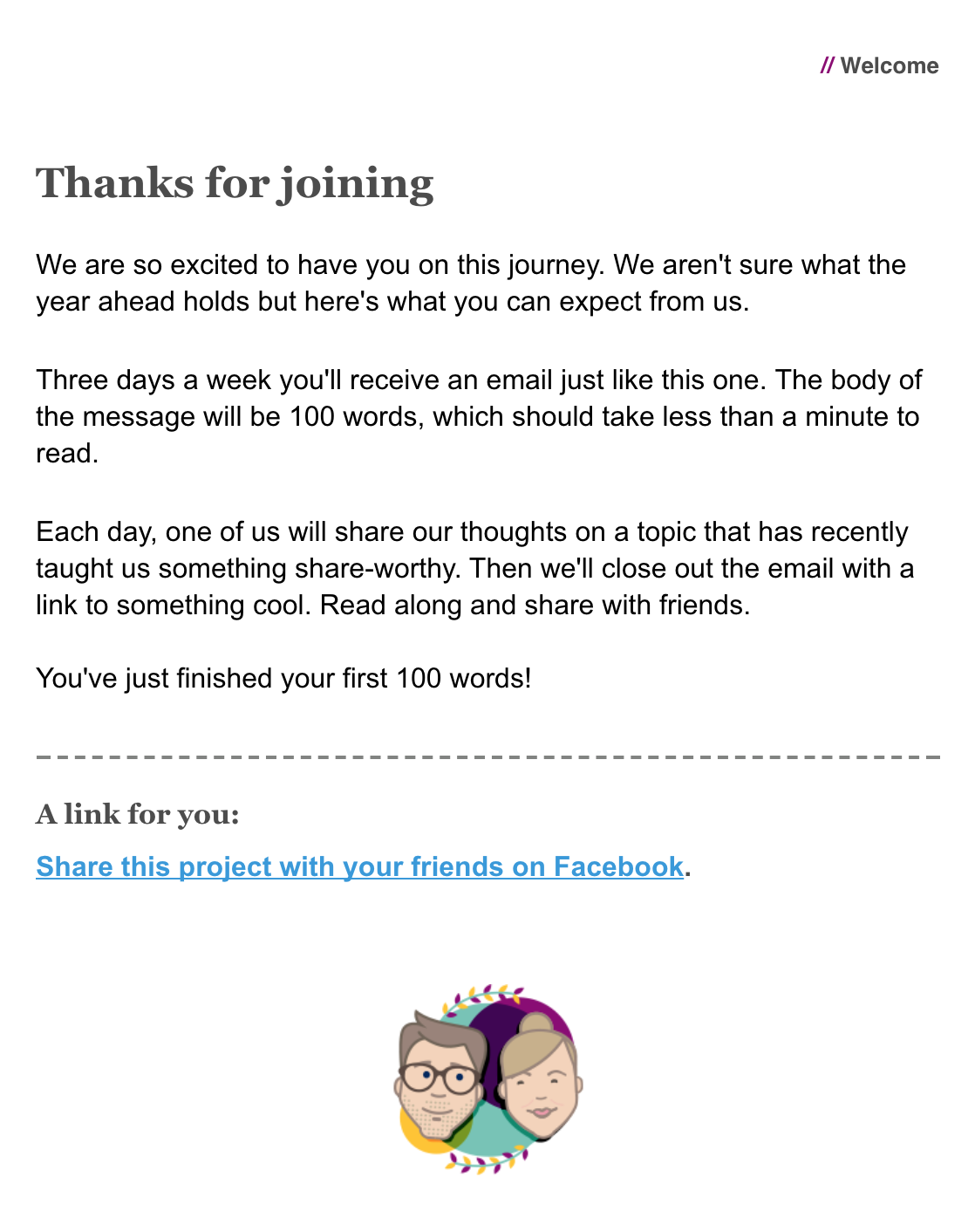 (You can find the archive of all the 100-word emails here.) The very first email went out on January 2, 2017. Here were the outcomes of our little year-long experiment.
(You can find the archive of all the 100-word emails here.) The very first email went out on January 2, 2017. Here were the outcomes of our little year-long experiment.
1. We are better writers now.
At first, it seemed easy to write 100 words. Then, suddenly, you’re staring at 500 words on the screen. That’s when the real work begins. Lindsay and I had to be tough editors to get exactly 100 words every single time. We had to be concise (which was hard for us—we’re both ramblers!) without stripping away any context. Over the course of 12 months, this got easier and easier. Now, whenever I write, I carefully choose my words. If I can write a sentence in 10 words instead of 15, I do it. I'm a more succinct communicator since ending this experiment. (Try it for yourself! Go to wordcounter.net and begin typing a sentence. See how how quickly 100 words can flow from your keyboard to the screen?)2. Our open rates were extremely high.
The typical open rate—the measure of subscribers that opened your message—will vary depending on your industry, but 20% to 40% is the average. Our average open rate was 57%. Our high open rates were due in part to our small list (approximately 80 people because we didn’t do much promotion). As your list size goes up, your open rate typically falls. But our high open rates was also due to our short-and-to-the-point content. Our subscribers knew exactly what to expect from us. We never wavered. We never sent a 90-word email or a 105-word email. We never tried to sell them anything. We never took advantage of the fact that we were invited into their inboxes. Every single individual on that list was important to us. At the end of the day, I’d rather have 80 highly engaged subscribers than 1,000 that never open or read our emails. (Is it time to purge your list of subscribers? Find out here.)3. We had a low unsubscribe rate.
Because our emails were just 100 words and super conversational, we ended up building relationships with a large portion of people on our list. Many of our readers would email us back and give us their thoughts, suggestions, feedback, and advice. If we missed a post, they would email us to ask why we were slacking. (They kept us motivated!) We only had a handful of people unsubscribe over the course of the year. I was recently reminded of a video by American author and marketing guru Seth Godin. In it, he says, “permission is the privilege of being looked forward to and being missed if you were gone.” I think this list of subscribers gave us that level of permission! They invited us into their inbox. They liked our content, opened it, engaged with it, and continued to invite us back week after week for an entire year. When you get to that point with your audience, you know you're doing something right.4. The feedback was overwhelmingly positive.
At the bottom of our emails, we always included a hyperlinked question “Did you like this email?” If the reader clicked the link, they were taken to a form to tell us why. These micro actions allowed for a feedback loop. People clicked through and left their reactions to our musings. They told us they looked forward to the short, snackable content every week, and their comments sometimes spurred new email topic ideas. Plus, the affirmations helped keep us energized to make it the full 12 months. If you want to set up something similar on your own emails, you can embed a sentiment widget. It allows you to track feedback on every message and learn what your audience likes and dislikes about your content. It’s a great way to constantly hone your emails and improve your open and click-through rates. Click here to learn how to embed your own sentiment widget.Should you shorten the length of your emails?
One hundred words is an aggressive constraint, but it really forces you to edit yourself. Turns out, you don't need as many words as you think you do to write well. Now, I'm not saying you need to commit to a year of 100-word musings. But give it a try every now and then. For instance, if you send a weekly newsletter, keep your intro to 100 words or less. Your readers may appreciate the brevity. You can also send 100-word emails over a shorter timeframe, like two weeks or one month. Then track open and click-through rates and sentiment widget feedback to see if there's a change in your subscribers' behavior. They may start interacting more with your content than they did when it was longer. If you're looking for more email writing tips, check out this FREE What to Write course. You'll get 45+ email content templates to help you craft the perfect message every single time.The post I Sent Only 100-Word Emails for One Year and Here’s What Happened appeared first on Email Marketing Tips.
from Email Marketing Tips http://ift.tt/2BZL3JJ
via IFTTT
Tuesday 13 February 2018
Killer robots aren’t as scary as the ones that make our lives easier

If sentient AI takes over the planet, it won’t be killer robots that destroy mankind. It’ll be the machines we designed to make our lives easier. If we’re lucky, they might just take pity on us. We’re a generally sad and self-destructive species with most of us likely to suffer from some form of physical, mental, or emotional malady before we eventually expire. This expiration is, perhaps, the crux of the problem. Because of it, our brains are inherently flawed neural networks. They have a primary governing rule called “stay alive” that’s completely at odds with the physical limitations of…
This story continues at The Next Web
from Social Media – The Next Web http://ift.tt/2BsQ38H
via IFTTT
Using Sprout to Understand Customer Sentiment
Feelings. They’re complicated. Especially where social media is concerned.
Throughout existence our brains have evolved to connect the dots of our experiences into meaningful patterns, but the boom of social media and digital language has made comprehending sentiment an entirely new beast.
This dilemma is particularly frustrating for marketers. Research has shown that people only agree on the sentiment of Tweets 60-80% of the time. Emojis, sarcasm, slang, limited context—these nuances in a new era of communication make opinion mining the world’s largest, most diverse and accessible focus group a not-so-pleasant job.
So how can today’s brands accurately gauge the public opinion of their online followings and keep up with customers in the place where they share their most candid feedback?
Sprout’s own listening solution for Twitter, now available as an add-on for Corporate and Enterprise plans, aims to be the answer to that very question. There are two features to Sprout’s listening suite that make the job of gauging customer sentiment a lot less overwhelming.
We Can All Benefit From a Good Listener
You can take the analytics around topics relating to your brand a big step further by creating a Sprout Listener. Access insights specific to the topic or hashtag you’re looking to dig into. You’ll uncover a variety of keywords and phrases that are negatively or positively associated with the Listener you set up.
The major difference between the analytics you track around a keyword and this method is that now your Listener will track the topic’s related hashtags, automatically bucketing them into positive and negative sentiment. You’re able to click into each bucket and see messages individually for more context.
For example, you’re the Director of Brand Strategy at a major food and beverage company. You’re in the midst of rebranding and in tracking social conversations using a Listener you discover the related topics under negativity are “sugar” and “concentrate.” This information guides your brand repositioning toward more health-conscious efforts and helps you directly tackle real customer concerns.
Essentially, a Listener does all the work—automating the process of organization and giving you presentation-ready metrics (regarding the topics that you consider most vital to your brand) to view and share.
Track Spikes in Positive vs. Negative Sentiment
To dive a little further into analyzing customer sentiment, Sprout features Emotional Response data in your Listener’s dashboard. This gives you a visual and quantifiable breakdown of distribution between positive, negative and even neutral sentiment to any topic or hashtag, as well as strictly positive vs. negative sentiment.
You’re able to click into the metrics and see every Tweet, gauging emotional resonance by measuring and analyzing sentiment to better understand your brand’s perception in the marketplace.
For example, a global car manufacturer could create a Listener in their latest car model’s name to seek unbiased feedback for improvements. With Emotional Response rates fixed into their reporting, it’s simple for them to note spikes in positive or negative sentiment. If they notice a significant jump in negative sentiment (compared to the previous reporting period) it’s easy to click into the metric and view the negative Tweets in one stream.
Understanding customer sentiment on social is listening to what your customers really have to say on the biggest stage there is. If you’re truly taking advantage of listening tools available, you’re not just gaining audience insight, you’re leveraging feedback to implement change.
Sentiment analysis can never be a perfect science, that’s true. But despite the fact that we can’t teach a machine every nuance of modern language, we can make technological leaps that make the process of parsing social feedback much more efficient. Now brands and organizations can move forward with a stronger, more intimately informed marketing strategy and gain actionable insights not just from what their customers’ are saying, but how their customers are feeling.
This post Using Sprout to Understand Customer Sentiment originally appeared on Sprout Social.
from Sprout Social http://ift.tt/2HcvduJ
via IFTTT
4 Ways to Better Collaborate With Clients in Sprout
Figuring out methods for better collaboration is an agency pastime. But juggling multiple clients, multiple social accounts and multiple tools tends to make true collaboration tricky to navigate.
No matter the size or structure of your organization, implementing some of these workflows can help you and your agency proactively approach collaboration across multiple channels and touchpoints and will keep you from scrambling to catch up with clients.
1. Using Tasks to Deliver Engagement Opportunities
Many agencies are used to being the “doers”—doing the publishing, the community management, the reporting—but as an agency scales and brings in new business, being the doer for every client isn’t always an option.
To keep the communication strong and maintain a heavy hand in a client’s strategy and engagement, you can assign Tasks within the tool to act as a reminder for new suggestions, trends and opportunities.
For example, if you notice someone is frequently using a client’s branded hashtag, you can nudge the client with a notification in Sprout to say, “Hey, here’s a good opportunity to interact.”
It’s an easy step that lets your clients know you’re right there with them, monitoring their brand’s accounts, seeking out opportunities and providing them with actionable expertise, even in times that you’re unable to be the doer.
2. Take Full Advantage of the Asset Library
The Asset Library really simplifies collaborative publishing. In line with the promise of a collaborative workflow for client and agency, this feature lets you customize the experience of asset management.
Sometimes a client just needs to see what they need to see. So to avoid overwhelming them in the library, apply user permissions and organize assets with tags and filters. Within the Library you can even leave notes about when to use particular images or, perhaps more importantly, warnings for when not to use certain images.
Combined with the Asset Library’s integration with Compose, storing, editing and publishing is seamless.
It’s likely that your client has several Google Drive folders or Dropbox accounts to manage images and design assets. You streamline all that for them by working together to move and store everything in Sprout’s Asset Library.
3. Align on Customer Communication With Tasking
You’re managing the inbox for a client, diligently going through each message and come across one from a disgruntled customer. Whether that message needs a carefully-crafted response or needs to be escalated immediately, the Smart Inbox is equipped to tackle that with both you and the client in mind.
Take advantage of Tasking in instances like these for a more collaborative workflow. Submit problematic social messages to the client as a task to align on healthy, on-brand responses easily.
It’s not lazy to send things to your client, in fact, it automates and streamlines the sometimes tumultuous and lengthy process of manual damage control. Just make sure the client is set up as a user in Sprout so you can Task and include your suggestions for a response. An email with your note will be sent so the client can respond in Sprout themselves or send you back a note with suggestions. The reply will then pop up in Sprout’s conversation history so all communication on the matter is accessible from one spot.
Without fully handing over the wheel, you can ensure you and your client are making decisions together in the tool.
4. Stay Ahead of Client Asks & Showcase Value With Scheduled Reports
Clients seek different things when it comes to reporting. Taking advantage of Sprout’s scheduled, customizable reports makes it easy to continuously meet the unique demands for each and every client.
After building out your social data, quickly and directly share presentation-ready analytics with them using Sprout’s Schedule Delivery functions. Your client will receive an automated email on a cadence you’ve chosen and you can opt to white-label the email and PDF, including their own brand logo(s).
It’s normal to automate processes during particularly hectic times for your agency, but to still have control in an automated process with customization is a real win/win.
To make each report work for you, leverage Message Tags to showcase quantifiable successes. Not only is this action showing your client the types of content that are coming in and how they’re being received, but those tags are reflected in your analytics, allowing you to pull from the Tag Report to hopefully show some great numbers and how social campaigns are performing.
The success of working with clients doesn’t come down to who takes the lead. It’s about building the brand together, consistently and collaboratively. Making a few tweaks here and there within Sprout’s platform to adjust to not only your agency’s needs, but your clients’ needs too, is a big step toward just that.
This post 4 Ways to Better Collaborate With Clients in Sprout originally appeared on Sprout Social.
from Sprout Social http://ift.tt/2G9exmE
via IFTTT
Monday 12 February 2018
Buying a Belief: 4 Brands That Won by Taking a Stand
Stay out of it.
Take the path of least resistance.
Avoid hot-button issues.
Up until now, this has been the predominant mindset of brands amidst major sociopolitical change, division or scandal.
But as today’s political climate continues to spiral and trust in institutions is at an all-time low, consumers have begun looking to brands to step up and take the lead in effecting change.
According to a 2018 survey by Sprout Social, two-thirds of consumers (66%) say it’s important for brands to take public stands on social and political issues. And Edelman’s 2017 study, “Beyond No Brand’s Land,” found that more than half (51%) of respondents believe that brands have more power to solve social issues than the government.
Never before have brands held so much influence over societal changes. And although some brands may be uncomfortable stepping into this new role, they may not have a choice.
Nearly 60% (57%) of consumers are more likely to buy from or boycott a brand because of its stance on a social or political issue. And for these “belief-driven buyers,” silence is not an option.
But with the recent missteps of brands like Pepsi and Uber, it’s understandable why brands may be wary to speak up. Luckily there are some brands that have gotten it right and whose success can provide a lesson to others looking to follow in their footsteps:
1. Patagonia – “The President Stole Your Land”
Last year when President Trump gave the order to dramatically reduce the size of two national monuments in Utah, Patagonia–along with the greater environmentalist community–responded with outrage and fear for the integrity and protection of these public lands.
To publicize the brand’s position and further educate the general public on the issue, Patagonia replaced its website’s traditional homepage with a confrontational headline followed by the company’s stance on the issue, further resources and suggestions to donate.
Why it worked: We learned in the Sprout study that relevance is key to reception. Environmental conservatism is at the heart of Patagonia’s brand. It’s in their company’s mission statement to inspire and implement solutions to the environmental crisis. So not only was their response a legitimate, warranted stance, but it was almost necessary given the values the brand was built upon.
It also worked because the revamped homepage was not simply an empty, isolated gesture or media stunt. Not only does Patagonia already have a proven track record of grassroots environmental efforts and generous donations, this particular campaign was accompanied by a giant resource catalog with education around public lands and next steps for visitors looking to take action.
2. Airbnb – #WeAccept
The popular home-sharing site drew national attention with the airing of their politically-charged TV commercial during Super Bowl LI. In response to President Trump’s nation-dividing travel ban, the aid boldly declared, “we believe no matter who you are, where you’re from, who you love or who you worship, we all belong. The world is more beautiful the more you accept,” followed by the hashtag #weaccept.
In addition to the ad, Airbnb CEO Brian Chesky released a statement a few days after the commercial aired stating the company’s goal “to provide short-term housing over the next five years for 100,000 people in need.” The company also pledged to contribute $4 million to the International Rescue Committee to support the needs of the globally displaced.
Why it worked: Again, this was a stance on an issue that directly aligned with the service that Airbnb offers. It was a natural space for the company to occupy.
And like Patagonia, Airbnb didn’t just stop at the controversial tactic. It was backed up by the promise of real action that offered to directly–and quite significantly – reduce the negative impact of the ban.
On top of that, the company’s very own CEO was the one making public statements—not a PR spokesperson or generic company entity. According to the #BrandsGetReal study, people like to see CEOs speaking up.
3. Heineken – “Worlds Apart”
Often described as the antidote to the disastrous Kendall Jenner Pepsi ad, Heineken’s “Worlds Apart” social-experiment-turned-TV-commercial is an example of a beverage company tackling tough cultural issues the right way.
In the experiment, two strangers are paired together to complete several DIY tasks while simultaneously getting to know a little bit about one another. After a level of respect and rapport is reached, it’s then revealed to the strangers that they each hold drastically opposing views on today’s most divisive, hot-button cultural/societal topics (ie. transgender rights, climate change and feminism).
The participants are then given the choice to either stay and talk it over with a Heineken in hand or part ways. After some expertly edited tense moments it’s revealed that everyone decides to stay and the audience is gifted with a montage of clips showcasing humanity’s very real capacity for kindness, empathy and acceptance—despite our differences.
Why it worked: Heineken does a lot of things right in this video. One, the lower production value and reality-TV vibe makes it feel less contrived and more authentic. Consumers can actually see themselves in that very situation. This demonstrates another facet of relatability that’s also very important.
Another big contributing factor is more about what the brand didn’t do. Unlike the Pepsi ad, Heineken didn’t position their product as the solution to these problems. It’s simply there to represent a bridge for discussion. Talking it over over a cold one is a common human experience. The brand didn’t over-promise or over-dramatize its role and what resulted felt genuine and authentic.
It was also very strategic in that it didn’t take a stance one way or the other on any of the topics. As mentioned above, Heineken took a lot of care in carving out exactly what the brand’s role is. It was less about choosing a side and more about positioning themselves as a way to unite people in the middle.
4. Ben & Jerry’s – “Save Our World”
Even before President Trump’s controversial withdrawal from the Paris Agreement made climate change a household topic, Ben & Jerry’s had been championing the fight for cleaner energy sources. Never one to shy away from social issues, the ice cream brand launched a full-scale campaign/movement to join the fight against climate change in 2015.
As part of the campaign, the brand released a new ice cream flavor, “Save Our Swirled,” as a message to their fans to share their stance (“if it’s melted, it’s ruined”). They also published a list on their website of “endangered flavors” that used ingredients at risk should climate change continue to affect global farming and food production. Their creative efforts culminated in the video linked above, highlighting the significance and severity of this movement using the clever analogy of melted ice cream.
These however were just the marketing pieces of the campaign puzzle. More active components included an emissions-free road tour to spread the message and a partnership with community-based organization Avaaz to help distribute their petition demanding action from the United Nations.That partnership contributed more than 10% of the 3 million total signatures Avaaz presented to the UN.
Why it Worked: Why this particular campaign worked is also why any of the brand’s political activism works: taking a stand on social issues is part of the brand’s DNA. It has been a part of their brand story from the very beginning when proceeds from company profit as well as generous donations were gifted to fund various community projects. The brand believes, “the strongest bond you can build with your consumers is over shared values.”
The company doesn’t view an issue as an opportunity to sell more ice cream, but rather the ice cream as an opportunity to shed light on the issue. It’s a completely value-first mission and mindset that’s rare in the marketplace.
And even when some brand backlash arose regarding the dairy industry’s heavy effect on climate change, the company took action pledging to take steps to lower their carbon footprint, as well as the long-awaited release of a line of vegan/non-dairy flavors.
Gone are the days when consumers only bought what you were selling. Now they’re buying what you believe in. And since staying out of the conversation may no longer be an option in the future, your brand may want to take a page from the playbooks of these brands doing it right.
This post Buying a Belief: 4 Brands That Won by Taking a Stand originally appeared on Sprout Social.
from Sprout Social http://ift.tt/2nUarbi
via IFTTT
Saturday 10 February 2018
Digital Natives Group’s Jonathan Jacobs on Adding Value Through Collaboration
#SproutPartner Jonathan Jacobs is Co-founder and Partner at Digital Natives Group—a digital marketing agency proudly located in “one of New York’s creative capitals,” Long Island City, NY.
The aptly named agency boasts an instinctive, inherent understanding of today’s connective technologies as a result of being “born into digital.”
We recently spoke with Jacobs about how he and DNG approach and accomplish effective collaboration with multiple client and partner stakeholders.
In your work at Digital Natives, where do you find the greatest need for collaboration?
For some of our clients, especially some of the larger organizations, there are a ton of different parties we need to collaborate across—whether it’s another digital agency, an internal party we don’t interface with as frequently or an outside PR agency. And although we consider all of our client relationships a partnership, we’ve got several clients that are pretty hands-on so collaboration in those cases is a must.
Tell us a little more about what that client collaboration looks like.
Our team produces content on a monthly basis, but on occasion our clients might have something they want to say, a link that’s of interest or an advocate they want to support. So we’ll have them go into the platform and save that content as a draft. At the end of the week we go in and take a look at everything, make sure everything is in the right brand voice with the right brand imagery and then we go ahead and queue it up.
We also use the shared Asset Library as a repository for visual inspiration. If our client happens to be a photographer or sees a graphic they like that they want us to recreate, they just drop it in the library. Now we’ve got a grouping of images or graphics we can use to help create a more collaborative aesthetic.
It’s no secret that collaborating across agencies can be difficult at times. With it being such an important part of your process, how do you ensure it’s more collaborative than competitive?
I think it’s important to remember the ultimate goal—to amplify each other’s work and improve the efficacy and success of the campaign. When we hear what another agency or internal party is working on, we try to have the mindset of, “What is a way that we can create something that will add value to what they’re doing? And what valuable tools can we provide them with to amplify their program?”
What do you think agencies need in order to attain that goal?
With what we do, transparency is huge. For a lot of organizations or individuals we work with, it’s their first time investing in a digital agency and making a commitment to the digital space. In those cases we advocate for bi-weekly calls for sharing and discussing projects. Ensuring they have a regular outlet to ask questions and talk openly helps to prevent the potentially problematic build up of underlying concerns and issues.
These calls also provide the opportunity to surface what everyone is working on and allows us to add value wherever possible with our own tools and expertise. So when a team is working on an offline program that doesn’t seem to have a digital activation, we can come in and say, “actually, if you’re able to capture some of those photo assets we can either amplify it after the fact online, or create a social campaign around it to help attract more individuals before the event even takes place.”
We also encourage monthly roundups featuring the projects everyone is working on for the campaign. For those parties that may not necessarily have that digital-first mindset, they might not realize how much we’re able to do online. So showing them some of the projects and initiatives we’re working on might just spark an idea for further collaboration.
This transparency definitely goes both ways as well. Whenever possible we grant external stakeholders with read-only access to our content in the platform, so they always have an insight into what we’re working on. This also helps keep messaging consistent and helps avoid any duplicate or competing efforts.
On that note of transparency, at what point do you think it’s most important to connect and/or align with other project stakeholders?
One of the things that’s been top of mind for me recently has been this idea of proper preparation and planning. Getting people to learn how to have an eye for and an understanding of what goes into producing good digital campaigns can be difficult. I think some people who don’t have a digital-first mindset think that because something’s online means it can happen really fast. So we’ve really pushed our partners to start thinking about campaigns three, four, five months in advance so we can really plan to launch at the right time of the cycle. We’ve seen some of our best work come from collaboration early on in the process.
This post Digital Natives Group’s Jonathan Jacobs on Adding Value Through Collaboration originally appeared on Sprout Social.
from Sprout Social http://ift.tt/2snqpPB
via IFTTT
Friday 9 February 2018
#SproutChat Recap: The Importance of Case Studies
We all understand that customer stories are a hugely integral part of marketing collateral, but how exactly does one go about creating a case study? And how can one showcase these case studies to their audiences and prospects?
In this week’s #SproutChat, Sprout All Star Elite, Erika Heald, joined us to share her insights on the value of case studies. This week’s participants chatted about the distinctions between case studies and use cases, best practices for conducting a case study and how to leverage them in your social strategy.
Full Context Creates a Better Story
We often conflate the terms use case and case study. Both are great for highlighting customer stories in your content strategy, but there are key differences. A use cases speaks to the benefit of a specific feature or use, while case studies provide a story in full-context—including the issue at hand, the resolution reached and key metrics throughout.
A1a: A use case details how someone is using your product or service. A case study goes farther than that, to provide the context of the problem it solved and the results from using it. #SproutChat https://t.co/N9V437jdQY
— Erika Heald | Freelance Chief Content Officer (@SFerika) February 7, 2018
A1b: If your case study only answers the question “How are you using [product]?” It is a use case, not a case study. #SproutChat
— Erika Heald | Freelance Chief Content Officer (@SFerika) February 7, 2018
A1c: A use case can give current or prospective customers ideas on how to use your product or service, but a case study provides the WIIFM—what’s in it for me. #SproutChat
— Erika Heald | Freelance Chief Content Officer (@SFerika) February 7, 2018
A1: A case study is more in-depth than a use case. Think more of answering the Ws AND how, instead of just the H. #SproutChat
— Netvantage Marketing (@netvantage) February 7, 2018
A1: use cases are generic and focus on the problem(s) solved by the product, a case study is a specific story of how a company used your product to solve their particular issues #sproutchat
— Jill Liles (@JillLiles1) February 7, 2018
A1. A case study is an in-depth look at how an organization grappled with an issue or solved a specific problem for the purposes of generalizing to industries or businesses at large. #SproutChat
— allison ryder (@allisonryder) February 7, 2018
A1 A case study should tell a story. For example: Challenge faced, Solution applied, then Results realized. #sproutchat
— Martin Lieberman (@martinlieberman) February 7, 2018
A1. My understanding is that a case study is specific to a particular brand's implementation where as a use case is more about the form in which something can be applied. E.G. A case study is a Dominos pizza but a Use Case is a recipe for pizza. #sproutchat
— Colby Reade (@colbyreade) February 7, 2018
A1: I feel like a use case would be equivalent to flash cards and a case study is the textbook…#SproutChat
— Shannonigans (@mausi_nana) February 7, 2018
A1. A case study goes in depth to what type of strategy works for a particular business or organization #SproutChat
— Cheval John (@chevd80) February 7, 2018
A1: Case studies are abbreviated narrative problem-solving accounts. Use cases on the other hand, technically describe why your product or service is the best fit for a job. #sproutchat
— SocialXpresso (@socialxpresso) February 7, 2018
Think Beyond B2B
While case studies may seem like a strictly B2B marketing move, they can be used in consumer marketing as well. Consumers are genuinely interested in hearing how brands have helped people achieve their goals.
A2a: Case studies are an important part of a #B2B sales process, but they can also work well for consumer marketers too. #SproutChat https://t.co/K7JTkNoUAb
— Erika Heald | Freelance Chief Content Officer (@SFerika) February 7, 2018
A2b: In fact, you often see sponsored influencer blog posts on the #B2C side that are, basically, paid case studies. #SproutChat
— Erika Heald | Freelance Chief Content Officer (@SFerika) February 7, 2018
A2c: This is a great example of a first-person B2C case study on @problogger detailing how to get into a daily blogging habit https://t.co/FgyPwtLvTv #SproutChat
— Erika Heald | Freelance Chief Content Officer (@SFerika) February 7, 2018
A2. Absolutely not. Every business needs to develop case studies to demonstrate how their product or service solved a customer need. From mega B2B corporations to local mom and pop shops so solopreneurs. #SproutChat https://t.co/0CIJ26vn6O
— Colby Reade (@colbyreade) February 7, 2018
A2: They could probably be used for B2C as well, but we usually use case studies for B2B and testimonials for B2C. #sproutchat
— SocialXpresso (@socialxpresso) February 7, 2018
A2: Definitely not. I think they are used more formally in B2B but customers in any industry can benefit from seeing how a product or service can help solve pain points in their lives. Case Studies (maybe we should call them Case Stories?) make things more relatable. #sproutchat
— LookBookHQ (@lookbookhq) February 7, 2018
A2: Not at all. Although they may be a little more "snackable" for B2C. but the underlying concept applies to anything #sproutchat
— Jill Liles (@JillLiles1) February 7, 2018
A2: Case studies aren't just for B2B companies. They can be used in a variety of fields to provide valuable, in-depth information. #SproutChat
— Express Writers (@ExpWriters) February 7, 2018
A2: You could use the same format for B2C and call it a Customer Success Story. #SproutChat
— Carole Cudnik ☕ (@cacudnik) February 7, 2018
Highlight Quick Information for Social
If you want to pull from case study content for social keep in mind that speaking to your social audience is much different than a one-on-one sales call. Tailor how you deliver content on your social platforms by sharing small nuggets of hard-hitting information or engaging visuals.
A3a: Case studies can produce all sorts of great content nuggets that can be used for social media. #SproutChat https://t.co/61HCKmRx9v
— Erika Heald | Freelance Chief Content Officer (@SFerika) February 7, 2018
A3b: For instance, you can use an image with a great quote as a standalone piece of social content, or with a link to the full case study. #SproutChat
— Erika Heald | Freelance Chief Content Officer (@SFerika) February 7, 2018
A3c: If you record all or part of your case study on video, you can easily use a short excerpt on social. #SproutChat
— Erika Heald | Freelance Chief Content Officer (@SFerika) February 7, 2018
A3d: I love this video case study from a social agency that worked with @CocaCola on an influencer campaign https://t.co/gWwBvnMgtC — it’s a great showcase of the agency’s work and their results. I could see a short version doing well on social. #SproutChat
— Erika Heald | Freelance Chief Content Officer (@SFerika) February 7, 2018
A3: Results of a case study that proved applicable to your audience could be summarized in to a blog and then shared through social channels.#SproutChat
— John Venen (@JohnVenen) February 7, 2018
A3: Yes, but it may look more like an ad. (Our product made this customer 40% thinner and grew back all his hair.) #sproutchat
— Brad Lovett (@Brad_Lovett) February 7, 2018
A3: Your case studies will have points that hit a nerve with different segments of your audience.
Find out who needs what information and tailor it to them based on where the spend the most time.#Sproutchat
— Jeff Higgins Reads Playboy For The Articles (@ItsJeffHiggins) February 7, 2018
A3: Yes! Our audience loves learning from other brands and case studies perfectly address this because they portray a result that other brands want to replicate. The case study shows them what they can do to get similar results. #SproutChat https://t.co/JUIwZiNyg4
— Simply Measured (@simplymeasured) February 7, 2018
A3. Absolutely. In previous B2B and B2C roles I would pull out "snackable" data points (often with a graphic) and share with a link to the broader case study for deeper info. Great thought leadership fodder. #SproutChat https://t.co/GhNtDjhbYK
— Colby Reade (@colbyreade) February 7, 2018
A3: We always pull intriguing data points from our case studies to create fun infographics that get shared on social. Smaller, quicker to digest, visual. #sproutchat pic.twitter.com/lyer2punkd
— Mike Bryant (@MichaelRo22ss) February 7, 2018
Communicate With Success Teams
While in the process of identifying potential case study interviewees, take care to connect with any individual that has an existing relationship with the point of contact for the account. This might be someone on your client success or sales team, but could also be a personal contact. Be sure to check in on the status of this person’s account and how happy they are as a client.
A4a: Always start by talking to your customer success team. You want to identify customers who are happy with your organization, and who have a long-term relationship with you. #SproutChat https://t.co/J4mXFY6W48
— Erika Heald | Freelance Chief Content Officer (@SFerika) February 7, 2018
A4b: There’s not a lot worse than working on an amazing case study only to be unable to publish it because they came up for renewal and you couldn’t come to terms with them. #SproutChat
— Erika Heald | Freelance Chief Content Officer (@SFerika) February 7, 2018
A4c: You also need to ensure you are talking to someone who has the ability to approve your publishing the case study. Proactively ask if you need to work with their legal/compliance team. #SproutChat
— Erika Heald | Freelance Chief Content Officer (@SFerika) February 7, 2018
A4d: Also, conduct the interview in the person's native language whenever possible. If they choose to do an interview in English and it's not their native language, don't try to feed them marketing talking points as "help" expressing their point. #SproutChat
— Erika Heald | Freelance Chief Content Officer (@SFerika) February 7, 2018
A4. You identify the right customers by the relationship you've built with them and how they use your products and services. #SproutChat
— SourceMedia (@SourceMediaCo) February 7, 2018
A4: We look at:
-Our relationship with the customer
-The length of our relationship
-The products they use
-How they use our products
…just to name a few. #SproutChat https://t.co/vKLYLrqHDd— Simply Measured (@simplymeasured) February 7, 2018
A4. You basically listen to them and see if they is a gap in the market and then you put together content that solves that gap #SproutChat
— Cheval John (@chevd80) February 7, 2018
A4: Luckily we have an amazing in-house client success team that is very familiar with all of their accounts and each individual success story. We meet with them often to get updates and find out who is likely to participate in a study. #sproutchat pic.twitter.com/1ObHDEePLu
— Mike Bryant (@MichaelRo22ss) February 7, 2018
A4: Most businesses have "ideal" customers, we always recommend starting with them. The hope is always the case study will attract more "ideal" customers. #sproutchat
— SocialXpresso (@socialxpresso) February 7, 2018
A4: My first response is to showcase a success story, BUT you could also highlight a failure that you learned from. #SproutChat
— constancegail (@constancegail) February 7, 2018
Test out Videos
Videos can be a great addition to your overall content plan for case studies. Even if you don’t have the resources for larger video production, you can utilize video for conversations with your interviewee to set a more conversational tone.
A5a: Absolutely! Even if I only plan to publish a written case study, I always do case study conversations through video conferencing. #SproutChat https://t.co/ZXPE7mZy88
— Erika Heald | Freelance Chief Content Officer (@SFerika) February 7, 2018
A5b: Talking to a customer on video chat makes your interview more conversational and human. #SproutChat
— Erika Heald | Freelance Chief Content Officer (@SFerika) February 7, 2018
A5c: You can take the audio from the conversation and use it to obtain a transcript (I do this a lot), or as podcast content later too. #SproutChat
— Erika Heald | Freelance Chief Content Officer (@SFerika) February 7, 2018
A5d: And once you are thinking about creating social video clips or other corporate videos, you’ll have a nice library of customer content to pull from. #SproutChat
— Erika Heald | Freelance Chief Content Officer (@SFerika) February 7, 2018
A5e: Here’s an example of a case study I produced, pulling together a series of stakeholder video interviews to create a unified story. There’s a text-only and a video version. https://t.co/Yjc668YIUd #SproutChat
— Erika Heald | Freelance Chief Content Officer (@SFerika) February 7, 2018
A5: It depends on how you will distribute these case studies and how that audience will respond to it. #SproutChat https://t.co/w5gpheWbAv
— Simply Measured (@simplymeasured) February 7, 2018
A5 I haven't seen one in this format but it could be fun! And since attention span is zip now a days probably more engaging #SproutChat
— Shannonigans (@mausi_nana) February 7, 2018
A5. You CAN, but you don't need to. Video can be a compelling way to tell the story, but you can also create a great visual as a PDF or microsite. The trick is you HAVE to make the video compelling and show the story, not just ten minutes of data. #SproutChat https://t.co/6fctJnOmqs
— Colby Reade (@colbyreade) February 7, 2018
A5: YASSSS! If you have a customer with a good story to tell and who is willing you should tell that story as many different ways as possible. Long form, short form, video form, speaking at events. DO IT ALL! #SproutChat pic.twitter.com/uqxFkKnLWo
— LookBookHQ (@lookbookhq) February 7, 2018
A5: If you can get video, get video! It's 2018, video is our sustenance. But prepare for it, we contract out our high level production and it saves us time and overhead. But don't bother if the sound quality sucks, mic it up. #sproutchat pic.twitter.com/tLXHFmDf6V
— Mike Bryant (@MichaelRo22ss) February 7, 2018
Put the Customer First
First and foremost, when interviewing someone for a case study, take the time to get to know them. Start the conversation off about their role at the company and background about themselves professionally. Setting this tone from the start tells customers right off the bat that this project isn’t merely about work, but about putting them first.
A6a: Never, ever, ever, start by asking “So, how do you use our product/service?” That is a great way to end up with a use case and not a case study! #SproutChat https://t.co/K5Zdb1LKEW
— Erika Heald | Freelance Chief Content Officer (@SFerika) February 7, 2018
A6b: Always start with a few questions that you use for every case study interview you conduct. You want to cover who the interviewee is, what problem they had, how your company solved that problem for them, and their results. #SproutChat
— Erika Heald | Freelance Chief Content Officer (@SFerika) February 7, 2018
A6c: I usually start with “Please introduce yourself how you’d like me to refer to you in our case study, and talk to me about what your life was like before [brand].” #SproutChat
— Erika Heald | Freelance Chief Content Officer (@SFerika) February 7, 2018
A6d: No matter how eager you are to publish, make sure you send it back to the person you’ve interviewed for their review and approval before you hit publish. You may have misconstrued something they’ve said, or they may have given you info they shouldn’t have shared. #SproutChat
— Erika Heald | Freelance Chief Content Officer (@SFerika) February 7, 2018
A6e: If you are an agency or a consultant, you can’t always share your customer results by name. This @sproutsocial case study does a good example of working around that: https://t.co/5uh7Mp2B6I #SproutChat
— Erika Heald | Freelance Chief Content Officer (@SFerika) February 7, 2018
A6: Always come prepared. Make sure you know all about the person you're interviewing, their company, etc. #SproutChat
— Express Writers (@ExpWriters) February 7, 2018
A6: Show you've spent time analyzing their challenges, are invested in their success. Then get into the weeds with specific pain points/solutions that will elicit useful info and build relationship in the process. #sproutchat
— LA Resident Tourist (@LA_Res_Tourist) February 7, 2018
A6: Some things to consider:
1. The hero of the story is an individual (not your brand)
2. Use visual when appropriate
3. Don't gloss over the implementation process.
4. Make it easy for sales to access and use#sproutchat— LookBookHQ (@lookbookhq) February 7, 2018
Join us next Wednesday, February 14, to chat with special guest, Marketo, about the relationship between social media and email marketing. Until then be sure to join our Facebook group to connect with other folks in the industry.
This post #SproutChat Recap: The Importance of Case Studies originally appeared on Sprout Social.
from Sprout Social http://ift.tt/2nW62nr
via IFTTT